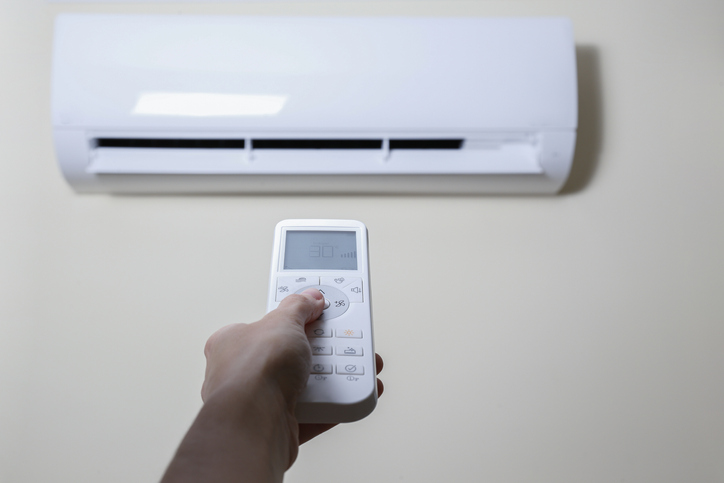How A Mini-Split Air Conditioning System Works
As summer approaches with more people likely at home during the hot weather, it might be no surprise that the demand for home air conditioning is high. Whether you need to cool a large home or a smaller space, the type of cooling system that will work best depends on a variety of factors that account for both your preferences, and your environment.
One of the more flexible options are ductless mini-split air conditioning systems, also called ductless air conditioning systems. We’ll look at how they work, why they make an appealing choice, and compare them against other air conditioning options.
Like central air conditioning, mini-split air conditioning has the same basic components — an outdoor compressor and an indoor air-handling unit. The difference is that with a central air system, the cool air is distributed through the house through a series of ducts. With a mini split, the unit is mounted to the wall in the room and requires no ductwork. The air handler portion of the system forces warm air across refrigerant lines, cooling the air, and then passing it directly into the room where it is mounted.

Some of the advantages to split air conditioning systems are the way they work and the flexibility that comes with their design.
Why People Chose Mini-Split Air Conditioning Systems

Mini-split air conditioners offer flexibility in cooling and are especially well suited for cooling individual rooms or portions of dwellings that may not be connected to existing HVAC. Mini-split a/c systems can also be installed in more than one room, cooling additional locations while all connecting to the same outdoor compressor. This gives you individual temperature control room by room for those with very specific cooling needs.
Split systems can also be much more energy efficient than central air conditioning, since they don’t rely on ductwork to distribute cool air — which is where most leaks and inefficiencies are found in central air.
Many mini split air conditioners also offer different designs and mounting options so you can choose where, and how, your system will be installed in your room, whether that’s a ceiling mount, wall mount, or flush mount of either. Mini splits can be adapted for a variety of otherwise harder-to-cool-environments — learn more about the differences between mini split and central air conditioners.
What Makes Mini-Split AC Systems Different Than Other Systems
What primarily separates split systems from the air conditioning pack is their flexibility and energy efficiency. Additional advantages of the mini split air conditioner include:
- Easier installation than central air
- More efficient than both central air and window units
- Flexible solution to targeted cooling needs — offers room-by-room cooling and independent temperature control
- Many also offer remote controls and can be compatible with Alexa and Nest smart home platforms
How to Install a Mini-Split AC System
Installing a mini-split system involves a two-step process: installing the indoor unit and installing the outdoor unit. Once you take these two steps, you are on your way towards cooling your room! So, how do you install these units? That’s where we can help! Follow our quick step-by-step guide below.
How do I Install an Indoor Unit?
Installing the indoor unit in your room of choice is similar to mounting a TV on the wall. So, what are the steps you need to take?
- Locate a wall in your home that leads to the outside and be sure to avoid spots that are exposed to direct sunlight.
- Drill holes in the wall where you will eventually connect the indoor and outdoor units. These holes will be for the refrigerant lines, drain tubing, and control lines. Be sure to connect the tubing and lines to the indoor unit before mounting on the wall.
- From there, you are ready to install the air handler (indoor unit) like you would a TV on the wall, about 6 feet from the floor to the bottom of the unit. Your system should have a bracket and instructions on how this is done.
How do I Install an Outdoor Unit?
The outdoor unit installation has a much simpler process.
- Choose the location of the condenser (outdoor unit). This can be on the roof, the ground, or mounted on the outside wall with special equipment.
- Once you have this in place, you can connect the lines from the indoor unit to the outdoor unit. Be sure not to cut the lines as this can be very dangerous, leaking refrigerant into the air. Your specific model should have instructions on how to connect them.
- Attach the wires and tubing to the outdoor wall to ensure they are properly secured. You should now be good to go.
If you have any questions about the installation process or would like to have a professional come look at your system, Same Day Heating and Air Conditioning is here to help.
Comparing the Cost of Mini-Split AC Systems vs. Other Systems
Mini-split air conditioning systems will generally land somewhere in the middle of the home cooling options —less than central air (usually) but more expensive than a window unit. Factors like:
- Size/square footage
- Number of rooms, or zones
- Cooling preferences
- Existing HVAC structure
All impact the price of a mini split, and should be considered before evaluating your cooling options. In general however, expect to pay between three and five thousand dollars for a standard mini-split system and install.
Not sure where to start to get cool this summer? For more information on air conditioning, installation, servicing, and much more, call (619)762-30144 to speak to one of our HVAC professionals.
